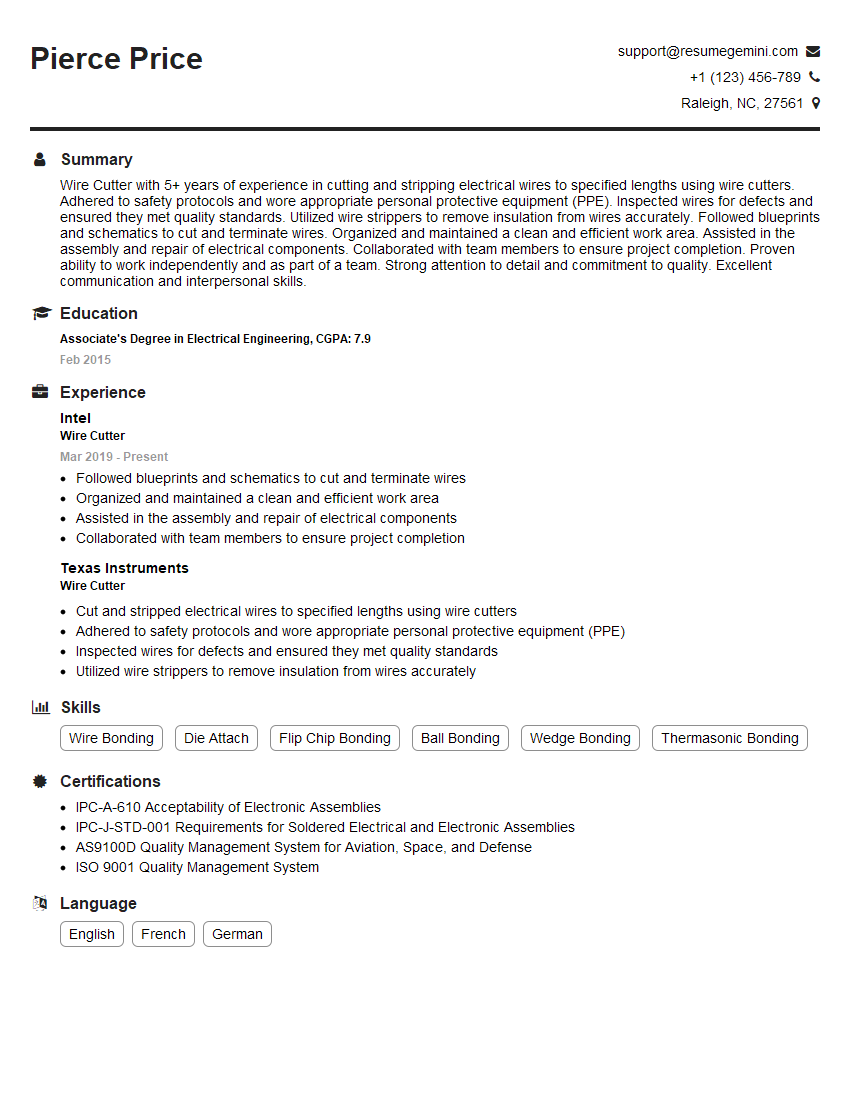Are you a seasoned Wire Cutter seeking a new career path? Discover our professionally built Wire Cutter Resume Template. This time-saving tool provides a solid foundation for your job search. Simply click “Edit Resume” to customize it with your unique experiences and achievements. Customize fonts and colors to match your personal style and increase your chances of landing your dream job. Explore more Resume Templates for additional options.

Pierce Price
Wire Cutter
Summary
Wire Cutter with 5+ years of experience in cutting and stripping electrical wires to specified lengths using wire cutters. Adhered to safety protocols and wore appropriate personal protective equipment (PPE). Inspected wires for defects and ensured they met quality standards. Utilized wire strippers to remove insulation from wires accurately. Followed blueprints and schematics to cut and terminate wires. Organized and maintained a clean and efficient work area. Assisted in the assembly and repair of electrical components. Collaborated with team members to ensure project completion. Proven ability to work independently and as part of a team. Strong attention to detail and commitment to quality. Excellent communication and interpersonal skills.
Education
Associate’s Degree in Electrical Engineering
February 2015
Skills
- Wire Bonding
- Die Attach
- Flip Chip Bonding
- Ball Bonding
- Wedge Bonding
- Thermasonic Bonding
Work Experience
Wire Cutter
- Followed blueprints and schematics to cut and terminate wires
- Organized and maintained a clean and efficient work area
- Assisted in the assembly and repair of electrical components
- Collaborated with team members to ensure project completion
Wire Cutter
- Cut and stripped electrical wires to specified lengths using wire cutters
- Adhered to safety protocols and wore appropriate personal protective equipment (PPE)
- Inspected wires for defects and ensured they met quality standards
- Utilized wire strippers to remove insulation from wires accurately
Certificates
- IPC-A-610 Acceptability of Electronic Assemblies
- IPC-J-STD-001 Requirements for Soldered Electrical and Electronic Assemblies
- AS9100D Quality Management System for Aviation, Space, and Defense
- ISO 9001 Quality Management System
Languages
- English
- French
- German
Career Expert Tips:
- Select the ideal resume template to showcase your professional experience effectively.
- Master the art of resume writing to highlight your unique qualifications and achievements.
- Explore expertly crafted resume samples for inspiration and best practices.
- Build your best resume for free this new year with ResumeGemini. Enjoy exclusive discounts on ATS optimized resume templates.
How To Write Resume For Wire Cutter
Highlight your experience and skills.
Be sure to list your experience in cutting and stripping wires, as well as any other relevant skills, such as wire bonding, die attach, flip chip bonding, ball bonding, wedge bonding, and thermasonic bonding.Use keywords.
Include keywords that potential employers will be searching for, such as “wire cutter,” “wire bonding,” and “electrical assembly.”Quantify your accomplishments.
When possible, quantify your accomplishments to show potential employers the impact of your work.Proofread your resume carefully.
Make sure your resume is free of errors before you submit it to potential employers.
Essential Experience Highlights for a Strong Wire Cutter Resume
- Cut and strip electrical wires to specified lengths using wire cutters.
- Adhere to safety protocols and wear appropriate personal protective equipment (PPE).
- Inspect wires for defects and ensure they meet quality standards.
- Utilize wire strippers to remove insulation from wires accurately.
- Follow blueprints and schematics to cut and terminate wires.
- Organize and maintain a clean and efficient work area.
- Assist in the assembly and repair of electrical components.
Frequently Asked Questions (FAQ’s) For Wire Cutter
What is a wire cutter?
A wire cutter is a tool used to cut electrical wires. It typically consists of two blades that are sharpened and angled to cut through wire cleanly.
What are the different types of wire cutters?
There are many different types of wire cutters, each designed for a specific purpose. Some of the most common types include:
- Diagonal cutters
- End cutters
- Flush cutters
- Strippers
- Crimpers
How do I use a wire cutter?
To use a wire cutter, simply position the wire between the blades and squeeze the handles together. Be sure to use enough force to cut through the wire cleanly, but not so much that you damage the wire or the cutter.
What are some safety tips for using a wire cutter?
When using a wire cutter, it is important to follow these safety tips:
- Wear safety glasses to protect your eyes from flying debris.
- Do not use a wire cutter on live wires.
- Be sure to cut the wire cleanly and avoid leaving any sharp edges.
- Store the wire cutter in a safe place when not in use.
What are some tips for choosing the right wire cutter?
When choosing a wire cutter, it is important to consider the following factors:
- The type of wire you will be cutting.
- The size of the wire you will be cutting.
- The frequency with which you will be using the wire cutter.
- Your budget.
What are some of the best wire cutters on the market?
Some of the best wire cutters on the market include:
- Klein Tools 11045 Diagonal Cutting Pliers
- Knipex 74 01 160 Diagonal Cutting Pliers
- Channellock 319 Diagonal Cutting Pliers
- Irwin Tools 2078300 Diagonal Cutting Pliers
- Southwire 22005 Diagonal Cutting Pliers
How do I maintain my wire cutter?
To maintain your wire cutter, it is important to:
- Clean the blades regularly with a wire brush or cloth.
- Oil the blades lightly with a few drops of oil.
- Store the wire cutter in a dry place when not in use.
What are some common problems with wire cutters?
Some common problems with wire cutters include:
- Dull blades
- Loose or damaged handles
- Sticking blades
- Rust or corrosion